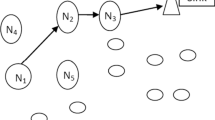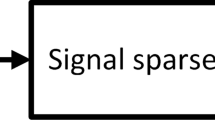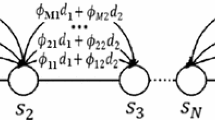Abstract
In recent years, localization has been recognized as an important supporting technology for wireless sensor networks (WSNs). Along with the increase in WSN indoor applications, indoor localization has become a hot research topic and many localization algorithms have been studied. Among these algorithms, the localization method based on compressive sensing theory emerges as a popular approach to indoor localization. In this approach, the nodes are sparse when compared to the number of grids utilized to represent the locations of the nodes, so the locations are considered as sparse signal and can be reconstructed using the compressive sensing techniques. The localization problem is formulated as the sparse reconstruction of sparsifying matrix which is comprised of measurement of received signal at grids. In order to improve the localization accuracy and meet the real-time requirement of localization applications in large indoor area, an indoor localization algorithm based on dynamic measurement compressive sensing for wireless sensor networks is proposed. Using the bounding-box method, we firstly identify a potential area that possesses the independent features. Instead of using the entire node deployment region as the measurement area, our method can decrease the number of meshing and also the dimension of measurement matrix. Meanwhile, we assume that only the anchor nodes which have communication relationship with the unknown nodes can be used as the measuring nodes; the measurement matrix of unknown nodes which need to be localized can be dynamically constructed according to the potential area and the received anchor node information, and the maximum number of measurement is decided by the number of grids of potential area. The proposed algorithm can mitigate the measurement redundancy and improve the real-time feature. Simulation results indicate that the proposed algorithm can reduce the time complexity and also maintain good localization accuracy and localization efficiency.

















Similar content being viewed by others
References
Cullar D, Estrin D, Strvastava M (2004) Overview of sensor network. Comput J 37:41–49
Tabibiazar, A. Basir, O. Compressive sensing indoor localization. In: 2011 IEEE international conference on systems, man, and cybernetics (SMC), 9–12 October 2011, pp 1986–1991
Donhon D (2006) Compressed sensing. IEEE Trans Inf Theory 52:1289–1306
Candes E, Compressive sampling. In: Proceedings of the international congress of mathematicians, Madrid, Spain, 2006, pp 1433–1452
Chen F (2010) Research and implementation of a compressive sensing-based indoor positioning system using RSS. Beijing Jiaotong University, Beijing, pp 1–30
Kaemarungsi K, Krishnamurthy P (2004) Modeling of indoor positioning systems based on location fingerprinting, In: Proceedings of IEEE INFOCOM, pp 1012–1022
Moghtadaiee V, Dempster A (2014) Indoor location fingerprinting using FM radio signals. IEEE Trans Broadcast 60(2):336–346
Youssef M, Agrawala A (2008) The Horus location determination system. Wirel Netw 14:357–374
Chen G, Zhang Y, Xiao L, et al. (2014) Measurement-based RSS-multipath neural network indoor positioning technique. In: Proceedings IEEE Canadian conference on electrical and computer engineering (CCECE), May 2014, pp 1–7
Au AWS, Feng C, Valaee S et al (2013) Indoor tracking and navigation using received signal strength and compressive sensing on a mobile device. IEEE Trans Mob Comput 12:2050–2062
Zhou M, Zhang Q, Tian Z et al. (2014) Correlated received signal strength correction for radio-map based indoor Wi-Fi localization. In: Proceedings of international conference on computing, communications and networking technologies, July 2014, pp 1–6
Feng C, Valaee S, Zhenhui T (2009) Multiple target localization using compressive sensing. In: 2009 IEEE global telecommunications conference (GLOBECOM’2009), pp 1–6, 30 November–4 December 2009
He FH, Yu ZJ, Liu HT (2012) Multiple target localization via compressed sensing in wireless sensor networks. J Electron Inf Technol 32:716–721
Li Y, Huang H, Fang Y (2014) Target localization via compressed sensing based on SVD. J Cent South Univ (Sci Technol) 45:1516–1520
Wang J, Xiaojiang C (2014) Compressive sensing based device-free moving target trajectory depiction. Chin J Comput 37:1–13
Zhang B, Cheng X, Zhang N et al. (2011) Sparse target counting and localization in sensor networks based on compressive sensing.In: 2011 Proceedings IEEE INFOCOM, Shanghai, China, pp 2255–2263, April 2011
Wang J, Fang D, Chen X et al (2013) LCS: compressive sensing based device-free localization for multiple targets in sensor networks.In: 2013 Proceedings IEEE INFOCOM, Turin, Italy, pp 145–149, April 2013
Patwai N, Ash JN, Kyperountas S et al (2005) Locating the nodes: cooperative localization in wireless sensor networks. IEEE Signal Process Mag 22:54–69
Serodio C, Coutinho L, Reigoto L (2012) A lightweight indoor localization model based on Motley-Keenan and COST. In: Proceedings world congress on engineering, vol 2, pp 1–6, July 2012
Liu Z (2011) The research on 3-D localization in wireless sensor networks. University of Science and Technology of China, China, pp 11–35
Jian J, Yuantao G, Shun-Liang M (2010) An introduction to compressive sampling and its applications. J Electron Inf Technol 32:470–474
Wei C, Jun Y, Weiping Z (2014) Wireless sensor network location algorithm using compressive sensing and multilateral measurements. J Signal Process 30:728–735
Acknowledgments
The work was supported by the National Natural Science Foundation of China (Grant No. 61402170, No. 61300039, No. 61572191), the Program Excellent Talent Hunan Normal University (Grant No. ET13103).
Author information
Authors and Affiliations
Corresponding author
Rights and permissions
About this article
Cite this article
Wei, Y., Li, W. & Chen, T. Node localization algorithm for wireless sensor networks using compressive sensing theory. Pers Ubiquit Comput 20, 809–819 (2016). https://doi.org/10.1007/s00779-016-0951-7
Received:
Accepted:
Published:
Issue Date:
DOI: https://doi.org/10.1007/s00779-016-0951-7




